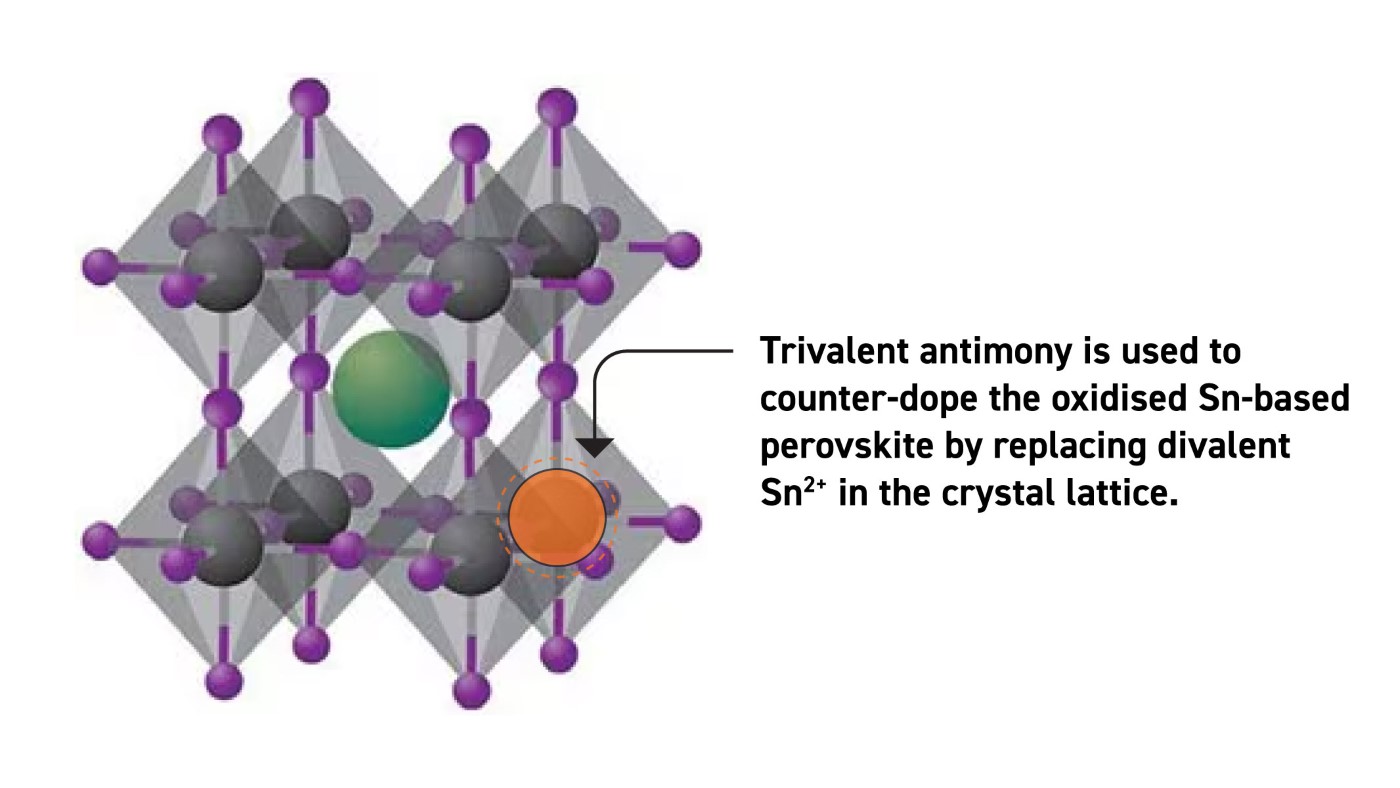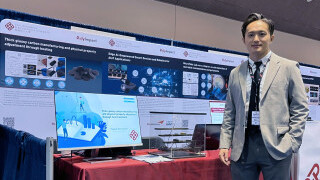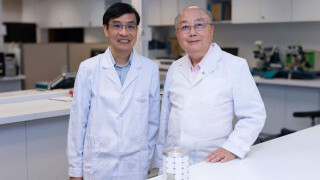Novel Strategy in Enhancing the Performance of Tin-based Perovskite Solar Cells
Other Articles

Introducing trivalent cations to counter-dope the oxidised tin-based perovskite layer and improve the carrier lifetime.
Study conducted by Prof. Feng YANand his research team
Perovskite solar cells (PSCs) are a type of photovoltaic device that utilises hybrid organic-inorganic perovskite materials. They have emerged as a groundbreaking technology in the renewable energy landscape, capturing significant research interest due to their remarkable efficiency and ease of fabrication. Despite their promising performance, the toxicity of lead present in many perovskite formulations hinder their widespread commercialisation. Recent research has focused on developing lead-free PSCs using pure tin (Sn)-based perovskites. However, Sn-based PSCs often suffer from severe carrier recombination issues, resulting in a low open-circuit voltage (VOC). The oxidation of Sn2+ in the perovskite active layer and the consequent strong p-type doping effect are major contributors to this problem Note1. Numerous studies have shown that the doping concentration in the active layer of tin-based perovskites ranges from 1016 to 1019 cm-3, which is significantly higher than that in lead-based perovskites. Heavy p-type doping introduces additional radiative monomolecular recombination pathways in tin-based perovskites, leading to reduced carrier lifetimes and suppressed carrier transport, thereby adversely affecting device performance.
In a study published in Advanced Materials, a research team led by Prof. Feng YAN, Chair Professor of Organic Electronics of the Department of Applied Physics at The Hong Kong Polytechnic University, proposes the use of trivalent cations (such as Sb3+ and In3+) to substitute Sn2+ in the lattice for the purpose of counter-doping oxidised Sn-based perovskites (Figure 1). Interestingly, the doping level in the Sn-based perovskite was decreased substantially down to 1014 cm−3 by adding a tiny amount of antimony (III) trifluoride (SbF3), leading to an increase of VOC and fill factor (Voc: represents the maximum voltage a solar cell can produce under conditions of illumination when the cell is not connected to any load. Fill factor: defined as the ratio of the maximum power output of the solar cell to the product of its Voc and short-circuit current (Isc)) of the PSC. Doping with just 0.01% of SbF3 increases the optimal power conversion efficiency (PCE) from 11.34% to 14.37%, meanwhile resulting in an average efficiency improvement of 31.4%.

Figure 1 Lattice structure of the tin (Sn)-based halide perovskites of the type ABX3.
The organic or inorganic cations occupy position A (green), whereas Sn2+ cations and halides occupy the B (grey) and X (purple) positions, respectively.
In addition to their impressive efficiency, the SbF3-doped devices demonstrated exceptional stability: when stored in a nitrogen (N2) atmosphere and measured under ambient conditions, they retained 95% of their efficiency after 1,500 hours. In contrast, the efficiency of the pristine devices degraded to 82% over the same time period.
The research team systematically analyses the impact of Sb3+ incorporation on the electrical properties of tin-based perovskite films, with a particular focus on revealing the partial participation of Sb3+ cations in the counter-doping process of Sn-based perovskites. Experimental and theoretical characterisations reveal that the incorporation of Sb3+ into the lattice of Sn-based perovskites can contribute additional free electrons, thus effectively suppressing the background hole doping level. In practical, only a portion of the Sb3+ enters the lattice to participate in the counter-doping process, while the remaining Sb3+ is distributed on the perovskite grain surfaces. First-principal density functional theory calculations further indicate that the presence of Sn vacancies within the perovskite crystal structure is a crucial factor affecting the lattice doping of Sb3+. When Sn vacancies are absent, the lattice doping of Sb3+ faces challenges; conversely, the presence of tin vacancies facilitates a small amount of Sb3+ lattice doping. However, when excessive Sb3+ is introduced, this trend is suppressed, leading to a preference for Sb3+ accumulation on the grain surfaces. This also explains the fact that even high concentrations of SbF3 cannot achieve n-type doping in Sn-based perovskites. At the same time, the Fermi level of the perovskite will rise, and the trap states located below the Fermi level will be filled with electrons, which helps to reduce defect concentration and enhance carrier lifetime.
Furthermore, in Sn-based perovskites, a significant number of point defects inevitably exist, among which iodine vacancies are common deep-level defects that can lead to severe non-radiative carrier recombination. When Sb3+ substitutes for Sn2+ near the iodine vacancies, it can shift the deep-level defect states to the valence band edge, effectively passivating the defects and enhancing the carrier lifetime and transport properties within the films.
This work provides new insights into the counter-doping effect of Sn-based perovskites through the introduction of trivalent cations. It highlights the significance of eliminating p-doping in the perovskite layer to develop high performance Sn-based PSCs with extended lifespans. It presents a novel strategy to compensate for the oxidation of Sn-based perovskites in optoelectronic devices.
The research is supported by the Research Grants Council of Hong Kong, China (Grants 15306822 and C1009-17EF), The Hong Kong Polytechnic University (Grant ZE2X), and the Shenzhen Science and Technology Innovation Commission (Grant SGDX20210823103401011). The data source is available at:
https://onlinelibrary.wiley.com/action/downloadSupplement?doi=10.1002%2Fadma.202402947&file=adma202402947-sup-0001-SuppMat.docx.
Prof. Yan was named as a "Highly Cited Researcher" by Clarivate Analytics for four consecutive years from 2021 to 2024. He was ranked among the top 2% most-cited scientists worldwide (for career-long) by Stanford University in the field of nanoscience and nanotechnology for five consecutive years from 2020 to 2024. Prof. Yan is currently the Director of the Research Center for Organic Electronics and the Associate Director of the Research Institute for Intelligent Wearable Systems of The Hong Kong Polytechnic University.
Note |
|---|
The presence of oxygen in the environment leads to the oxidation of Sn2+ in Sn-based perovskite accompanied by the formation of abundant Sn vacancy defects. This results in an increased concentration of positive charge (hole) carriers, i.e., the p-type doping characteristic in the material. These excess holes can recombine with photo-generated electrons through monomolecular and bimolecular recombination and thus reduces the number of charge carriers available for generating electric current.
| Reference |
|---|
[1] Wang, T., Loi, H., Cao, Q., Feng, G., Guan, Z., Wei, Q., Chen, C., Li, M., Zhu, Y., Lee, C., & Yan, F. (2024). Counter‐Doping Effect by Trivalent Cations in Tin‐Based Perovskite Solar Cells. Advanced Materials (Weinheim), 36(30), e2402947-n/a. https://doi.org/10.1002/adma.202402947
 | Prof. Feng YAN Director, Research Center for Organic Electronics Associate Director, Research Institute for Intelligent Wearable Systems |




